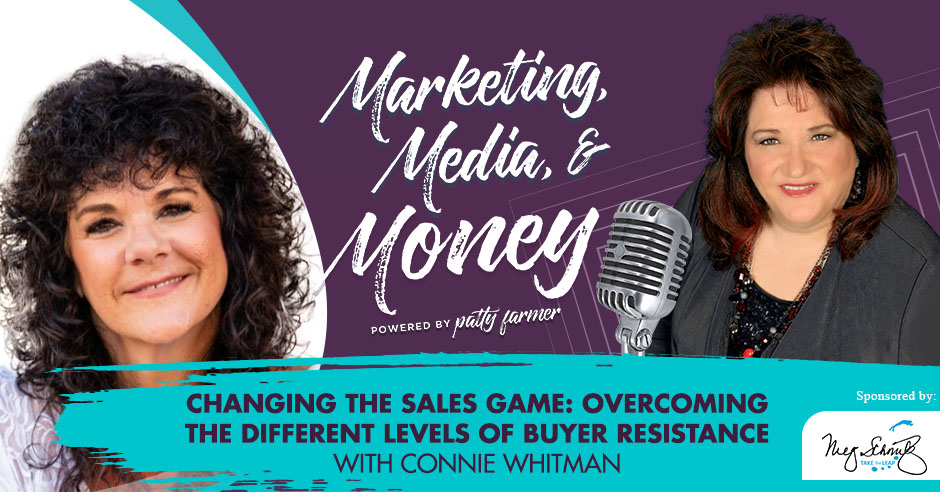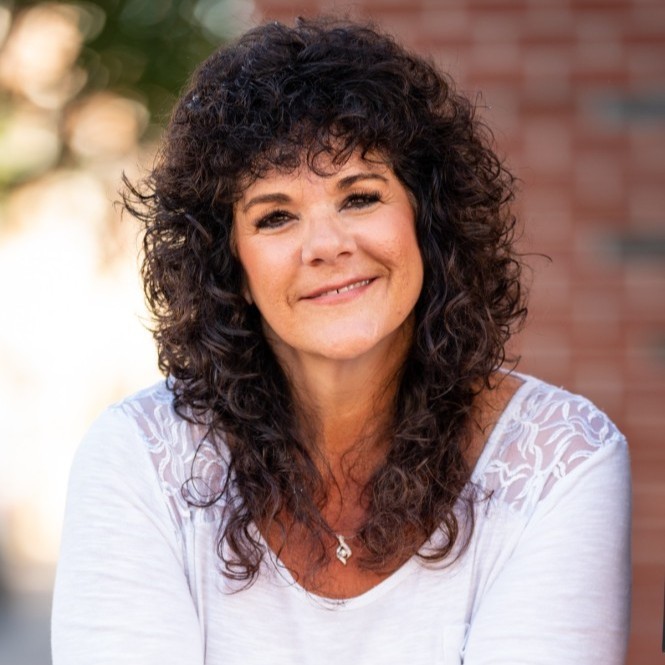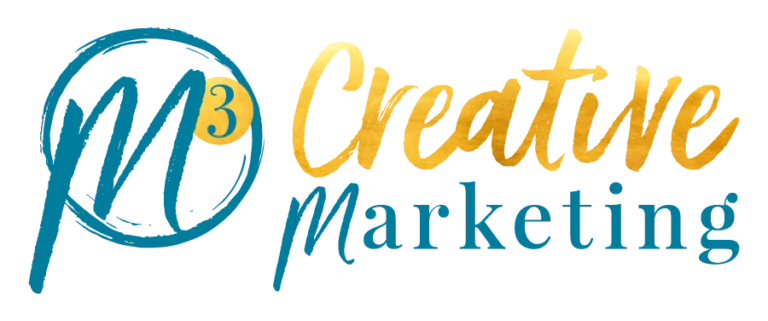
Click on the icon to listen to this episode on your favorite podcast platform.
Connie's Gift: Free Communication Style Assessment
Connie’s #1 Marketing, Media & Money Strategy
DID YOU LIKE THIS EPISODE? PLEASE GIVE IT A RATING AND REVIEW
About Connie Whitman

Known for her high-energy, passionate, heart-centered, and enthusiastic approach to sales, teaching and coaching, Connie Whitman has been the CEO of Changing the Sales Game for 20+ years helping business owners, leaders and sales teams build powerhouse organizations.
A three-time #1 International Best-Selling author of her book ESP (Easy Sales Process): 7-Steps to Sales Success, speaker, and podcast host, Connie’s inspired teaching, transformational tools and content ensure that business owners and salespeople grow their revenue streams through enhanced communication skills.
She is thrilled to share inspiring content on her international podcasts the “Changing the Sales Game,” and “Enlightenment of Change.”
Important Links
Grab Your Free Marketing, Media, & Money Assessment
Meet Our Sponsor
The Marketing, Media, & Money Podcast (and magazine) would like to thank our sponsor Meg Schmitz, founder of Take the Leap franchise consulting company.
The franchise industry is booming as people look to diversify their income streams with essential businesses, without having to quit their day job. If you have ever considered what it would be like to own your own business with the security of a solid brand behind you, schedule a call with Meg. The conversation is free, and the insights are priceless. https://MegSchmitz.com
Changing The Sales Game: Overcoming The Different Levels Of Buyer Resistance With Connie Whitman
We are going to be talking about how to get off the bench and get back in the game, the sales game that is. We all want to know what that is because we all want to be winners at the sales game. Let me tell you a little bit about our guest. She's known for her high energy, passionate, heart-centered, and enthusiastic approach to sales, teaching, and coaching. Connie Whitman has been the CEO of Changing The Sales Game for many years, helping business owners, leaders, and sales teams to build powerhouse organizations.
She's a three-time number one international bestselling author of her book, ESP-Easy Sales Process:7 Steps to Sales Success. She's a speaker and podcast host. Her teaching transformational tools and content ensure that business owners and salespeople like you grow their revenue streams through enhanced communication skills. Connie, thank you so much for being here with me.
Thanks, Patty. I'm excited to be here, and I hope we share some awesome content.
A lot of people probably think the sales game, “Let's get off the bench.” I love it and getting back in the game because that is something that people struggle with. I know that you like to talk about and teach buyer’s resistance. I love that term. My audience knows that we are all talking about the same topic, and maybe they are thinking of buyer’s resistance. What is that? How do I know? Is there anything you could share with us, maybe some signs that we know that we face the buyer-resistant monster?
That's a great place to start. I'm sure that there are going to be multiple yeses as I go through the list. There are seven signs that you are faced or you are facing buyer's resistance monster, I call it. The first one is you get nervous when you have to make a sales call. We hesitate, avoid, and procrastinate making those sales calls.
The 2nd one, you are sometimes hesitant to make the offer because you feel awkward at that point. Are they going to say no? Am I going to get objections? We have all of this subconscious stuff going on. The 3rd one is you feel like your competitors get ahead because they are more assertive or pushy than you. Sometimes we see pushy and then making money, and we feel like, “Do we have to do that?” The answer was no but that's another perspective or perception that we have.
The 4th one is you feel like your mission is to help people but you feel icky about asking for the business. “I'm here to serve but doesn't everybody have this gift, and I shouldn't charge.” It's a lot of mindset stuff that we are talking about here. The 5th one is you feel you would do better if you were better at sales or the client was a better client. Again, all of this stuff that’s going on.
The 6th one is you feel like you don't have the right personality for sales. “I'm an introvert. I'm not super friendly,” and all of those things. Here's the kicker. Most introverts are good at sales because they are very thoughtful and observant, which is a great skill when we are talking from a sales perspective or a sales conversation. The last one is you wish there were another way to get more business other than selling. It's like, “Do I have to sell? Can I have good marketing copy and make sales?” The answer is no.
I'm going to take a guess that my audience here has to be feeling at least 4 or 5 of them. I feel like people want to serve but they don't want to sell, and the reality is we are all selling. We are selling ourselves every single day, whether you have a product or a service, the first thing you are selling is you. Why should they buy it from you? I'm sure somebody does but you probably don't have a product or service that nobody else in the world has ever seen or heard of.
The question is, “Why should they do it with you? Why should they hire you for whatever that is?” That is a sales game and learning how to sell is probably one of the greatest skills we ever can. I believe that children learn it young. We stop doing it when we get older. Kids naturally do it when they are younger with each other, and I even think with their parents. They are always selling us on something.
Can I give you a great example of that? That's so brilliant. I have two boys. They are now men. My little guy was probably about 2 years old, maybe 3, and my cousin had a baby. I went over to see the baby. Of course, I brought munchkins. I figured my little guy can have some, and then she could have some. You don't ever go to a house empty-handed. That whole way of being raised.
We go in, so he says to me, “I want ten munchkins.” I said, “No, you could have three,” and he goes, “Ten munchkins.” I'm like, “Four.” By the end, he had seven munchkins. My cousin says to me, “He negotiated the crap out of you.” I go, “Yes. He's very good at it. I think he's going to be a lawyer someday. He's not.” That's exactly what you said.
Negotiation, and he didn’t do it. It was tenacious. He was tenacious in how he approached me, so he could get his seven munchkins. He started with the high, and then he worked his way down. He worked me over good. Here's the thing. It was adorable but that's negotiation. We forget that there's always room for negotiation with our clients too. Another silly story that you made me think of that when you said that about kids being so resilient and unaware that they are selling.
I have six daughters but my youngest daughter is and always has been the most professional negotiator. I even remember when she was a teenager but I caught on fast because I'm good at sales. I remember when she would do something, and I would be like, “You are grounded.” “How long am I grounded for?” I would be like, “You are grounded for a week,” and then she would negotiate with me and she's like, “What am I grounded from? I can't go anywhere. The phone, like what?”
She wants to negotiate what that was. I would be like, “You can't get on the phone. You can't go out.” I remember one time she said to me, “Mom, how about if you ground me for two weeks but one week it's from the phone and I can still go out and one week, I can't go out but I can still get on the phone.”
She was always negotiating, and it was so funny but even when she would want to say, “It's the dance. Can I please raise my curfew to 4:00?” I was like, “No. You can't raise your curfew to 4:00.” “Can I raise it to 2:00?” We would go back and forth but what she never realized was I already knew. I was going to let her raise it, and I decided what it was going to be.
I would let her negotiate. She walked away feeling like she had won. I felt like I had won. I think that in sales with your clients, the same thing is true. You want to let them be the hero of the story too. They walk away feeling like they’ve got what they wanted but yet you didn't have to give up any of your value or worth because you know how to have a pricing strategy, and I'm all about pricing strategy. Let's jump in. My first question is, can you define what buyer resistance is?
There are five layers, and I can go through each of them but here's the bottom line. We are taught to have buyer's resistance. Every human, even if you are good at sales, you too have buyer's resistance. Here's why. Movies like Wolf of Wall Street, Glengarry Glen Ross. That's an old one about insurance, “Always be closing.” We are it made off the new one that De Niro was on all of this media hype.

Buyer Resistance: Most introverts are really, really good at sales because they're very thoughtful and observant, which is a great skill when we're talking from a sales perspective or a sales conversation.
You see the Ginsu Knife, “But wait, there's more.” That whole vibe of that pushy, that icky that you have to be loud and, in your face, and manipulating the client is what we are taught sales is through our own experiences. You go to Best Buy, and you want to buy a TV, and the guy tries to push you into other things that you don't necessarily need.
Sometimes you walk away thinking, “He was so brilliant, and I did need all these things. I didn't know I needed them,” but you feel good about the purchase. That person did a good job for you. They didn't just sell you, they really sold you what you needed, told you why, and educated you. To me, that's a good sale. The other one is when you go home and you think, “Why did I say yes to all this crap? I don't need half of this stuff. Now I have to go back and return it.” You feel duped. Every one of us and even your readers has all been in the position of being duped. “I’ve got ripped off again.” It's always there, and I want to share one other thing with your readers.
There are two conversations always going on. Patty and I were having a very English conversation. We are speaking English. We could see each other on Zoom or watch our body language, so we are not talking over each other. The very conscious part of conversing with people, with humans. We also have a subconscious conversation always going on, and it's always under the surface.
Picture an iceberg. Ten percent of our conversation is at that conscious level. Ninety percent is happening at the subconscious, emotional, response perspective. It's under the water, if you will. That's happening every time we are sitting with our clients. They have you already think, you are not thinking this logically but this is what's going on to you subconsciously. The seven monsters I mentioned that was all subconscious. What if they don't buy for me? What if I get an objection?
You are already thinking about the buyer's resistance. Meanwhile, your client is coming to the table with the five layers of buyer’s resistance. I want to teach one more word to your readers. To me, this is science. There's a logical progression to break down the five layers. After you break down the five layers you have in front of you, the objection lists buyer. They have always been there.
You had to earn the right to be able to be face-to-face with that objection list buyer, and the only way to do that is to satisfy those five layers of buyer's resistance. Break them down one by one. The objection was buyer is there waiting for you with their credit card ready, invoicing, whatever it is for them to say yes, and sign up with you.
Before you tell us what the five layers are, I want to step back a minute. What I wanted to know was, how did you happen to get into this? I know you didn't wake up one day and say, “I want to work in buyer resistance and be in this sales game.” There's a little bit of a story there. There always is. Not too much even sales because I'm sure that is too but specifically this, because this is a great area and something people need to know and can literally dare I say, “Change the game on sales.”
I have been in sales and business for many years. It was funny because, for the first nineteen years in sales, you figured it out. I had all different types of training, some good and some not so good but I created my signature class. It was my signature process that worked for me. All of the learnings I went through in the training. Some of it, I walked away thinking, “I would never do that.” Some I was like, “That felt good. I could do that with my clients. I can develop that skill.” That was the first 19 years and then 20, all of a sudden, I had clients. I have to teach them sales.
You are good at something. How do you translate that? That's when I sat back and thought, “What do you do? Why are you successful at sales?” That's when I came up with my 7 Steps Sales Process, which I have in the book that you spoke about earlier. I published that during COVID. I have my signature class, which is a nine-week class.
As you are teaching, you are realizing how do you break this down, so people go, “That does happen to me.” It's that relationship of understanding. I communicate that because it's logical five layers. If I could take control logically and break down those five layers, sales would become easy. Now I have a tool, a system that I can rinse, repeat, get better at, and then your return on investment or your close ratio, whatever you want to call it, exponentially goes up. It was sitting back for myself and saying, “Why were you successful? What the heck do you do that's working?” Think about it too. What you bring to the table it's years of experience, and sometimes, it's subtle lessons that we learned that were the most impactful.
That's so true, and a lot of times, whatever people do for a living, whatever we do, we do have a process. I hear from my clients all the time, “I don't have a system or process.” No, you do. Sometimes you have it written down. Sometimes you systemize that process, and sometimes, you don't. The fact of the matter is you do have a process in some way, shape or form.
That process could be possibly more fine-tuned to make it more effective but you do have a process, whether it's a process that's working for you or a process that's not working for you. Believe me, there is a process in there because we naturally tend to do that. When you can handle, understand and eliminate the five layers of buyer's resistance, you are going to because you are aware of them now.
It's a subtle shift. You can walk in feeling good. The bottom line is, it sounds like you are trying to sell somebody something that they don't need or want because if you are, then that's a whole other story. That's totally something different. If it is something that they are looking for a solution to, and you have the solution, the reality is you could feel so much better when you show up, when you know that you are there to serve them, and sometimes clients get in their own way. We all do.
How many times have we needed something, wanted something, and we put up all these roadblocks? Sometimes the reason why it takes us longer to be successful is that we get in our own way. Why would we think that our clients aren't doing the same thing? We can help them eliminate that buyer's resistance. We are doing them a favor and helping them. Let's go ahead and dive in, and we will take them one at a time. What are the five layers of buyer’s resistance? We will wrap it up at the end.
You said that if they were pushing a product or service on someone, and it's not ideal for the client, they are not our clients. They wouldn't be working with me or with you. I only deal with people in integrity because we are here to serve, and I believe that with my soul, and you should get paid for it too but you’ve got to do the right thing for the client. Otherwise, that's why you are icky and sleazy, and you are not in my world. You are not my client because I won't teach someone like that who's going to go and rip somebody off. That's not cool.
The five layers, and I wanted to comment on that because you were 100% spot on. Number one is the time resistance. “I don't have the time. Is this going to be worth my while? How long does this going to take? I have a busy day. We are all very busy.” You have to go in super prepared so that you are on your game. Every client meeting, every time that you don't show up willy-nilly and you are winging it.
You were super prepared for this. I wasn't but you are for this interview. You have reviewed all my stuff. You pulled it together. You’ve got the questions you want to ask that you felt your audience would benefit from that's showing up prepared. That time element that we have, that 30 minutes together, we want to maximize every minute.
The client will see and feel that you have showed up for them. You start to build that like, know, trust factor right out of the gate. You show up in your hot mess, shame on you because that's something, even if you are a disorganized person, which is what a lot of people are. I get that. You and I are super organized. A lot of people aren't organized. When you are meeting with a client, you’ve got to be organized. You can learn that skill because it's that important. That was that's layer number one. Prove that me spending my time with you is worthwhile and that it's going to value me in some way. Do you have any questions?

Buyer Resistance: You're already thinking about buyer's resistance. Meanwhile, your client is coming to the table with the five layers of buyer’s resistance.
No. That is good. People do need to know that, and they can tell too there's no faking it. Somebody can tell if you are showing up and they set aside the time for you, and you are not prepared, and you've already lost them.
I do this for a living, so I am hyper-aware of people's deficits and strengths as they are selling to me. Don't think that I judge because I don't. Sometimes I buy from people, even if they don't break down all the layers because I could see beyond that. Most people can't is the issue. Somebody right out of the gate, they are a hot mess. They are not organized, and they start like, “What are we doing?” They waste the first five minutes of my time. I'm not going to buy from them. I could tell. I know when it comes to the deliverables, you don't even have the business, and you didn't show up for me. Forget it if I sign up for you, what are you going to deliver?
Already, for me, you probably blew off the sale. Each of these layers is super important. The second layer is where we start to build or shoot ourselves in the foot from a trust perspective. There are all these sorts of statistics out there but on average, it takes about 30 seconds for someone to formulate a vibe of who we are. First impression.
It's less. It could be a nanosecond where someone is judging us based on how we speak, what we look like, and how prepared we are. There's a lot of judgment going on because we are humans, and we judge. That's what we do. The second layer is you have to build trust by proving, right at the time, it's worth my time but that you are professional, that you are knowledgeable, that you care, that you are giving them the time to speak.
All of these things help build that like, know, trust factor, and that's how you build trust. I have a free gift which we will share at the end. It helps specifically with this second step of showing up authentic and letting the client feel you at that subconscious level and start building trust in that first 30 seconds. That's number two.
I have done a lot of time on this. It’s like you are the expert in your zone of genius. Step number three is where we start asking questions. Every one of these layers is so important. Please don't get me wrong but this one, we go in oftentimes, and I see it all the time with networking. People ask close-ended questions. They ask one question, and then they turn it back to them, and they want to tell you what they do so that, “You support me or buy for me.” Be careful when you are with a client, prospect or potential client. It's never about you. It's always about the client. Your questions have to be open-ended. Most people say, “We have an open-ended question.” Most of them don't have open-ended questions.
There's a process. You could see there are a lot of sub-skills under each of these layers. For this one, you have to not make sure not only are the questions open-ended. You are digging in and getting a lot of information that the flow of the conversation makes sense. Step two, with my free gift, talks about behavioral styles or personality. If I'm communicating with a personality with my questions and I'm all over the place, and that person needs a very logical process, you've lost the sale. They are like, “What is she talking about? She's all over the place.” There has to be a logical flow in the questions.
I also think that one of the things that are important here from a listening skill is they have to understand, know, and trust that you actually are listening to them. You are not waiting for them to take a pause so that you can jump back in and start telling them all the reasons why they should buy from you. I see that so often, and it's like, “We get that. We understand that but you can't help me if you don't listen to me to make sure that you understand what my problem is. Not what you perceive my problem is but what my problem is, otherwise, you can't provide me with the best solution for me.” You want to provide me with the best solution for you and that is important.
Many years ago, when I first started my business, I had a six-step sales process, and what was missing? Listening. About several years ago, after questioning the next step, we did not plan this, everyone. This is an authentic conversation. Patty had no idea that my 4th one was listening, and I gave it its own step. For the exact reason that you said. We, humans, have a six-second attention span, a goldfish has a longer attention span. How sad is that?
If we are not listening and the customers or the prospect is answering all of these great questions, not only with what I thought they might need but now they are expanding my perspective of how I might be able to help and introduce them to my network of people that I vetted and know are true blue and wonderful, and can deliver.
When I understand your expanded perspective, not only can I help you, but now, it bring you into the folds of my network, my people. Magic is starting to happen because I know who delivers the best at what price point, all of those things because I have vetted and worked with them oftentimes. Now you can share your network with them as well. In addition to making the sales, you become their best friend, your go-to expert for everything every time they have an event or some type of change in life or business, whatever it might be.
That is important. I'm in marketing and media now but back in the day, I used to own a mortgage company, and one of the things I learned early on there was that you weren't qualifying them. You were also disqualifying some of the things that you might offer them. By the time you get to the end of the conversation, you should know what the right thing was. For example, back in the day, I remember thinking, “These were all the mortgage solutions that I had.” When I would ask them questions and listen to them like, “How long do you want to have that house? Is this your forever home? Is this your starter home? What's the situation?”
In my mind, I would think, and I would start thinking, “No. That's not the loan for them. No. That one's not it. We don't want to put them in that loan.” By the time I got done listening to everything they had said, it only made sense that 1 or 2 of the products that I had fit everything that they wanted and why. I could be an expert and say, “Based on what you said,” and then I could repeat back to them what they said and why I chose these, so they knew that they were heard and why I felt like those were, and then they could go with that.
It's the same thing in marketing. My clients now, a lot of them will tell you, “I don't want to do video or I don't want to blog.” This is all the reasons why I don't do that or this, or whatever the case may be. It’s the same with sales. If you, who listen to what people are saying, you may think because always you show up at the call prepared like what you said. I have already been prepared. I looked, and based on what you see, you may think, “This might be one of the things that I could offer them that will help them.”
When you listen, you find out, “The reason why that was missing was that they don't want to do it or there's a genuine reason why they don't want to have that.” All of a sudden, you can't get to the end and say, “This is what you need to do when they are thinking, ‘Twenty minutes ago, I told you I didn't want to do that, so you weren't listening to me.’”
You have to be able to listen to what they are saying so that you know that when you get to the end of the conversation and you are getting ready to tell them how you can help them, that you have listened to everything he said, and it totally makes sense to them because they know that you heard them. That is important. You are not qualifying them. You are also disqualifying certain things that you may be able to offer them, so that makes sense at the end, the ones that you choose because you are the expert.
Listening, I say that in steps 3 and 4, they are married. They are doing a little dance because as you ask questions, you do have to listen. Here's a couple of little tips. You have to take notes, whatever that means for you. I have the remarkable, and then you can upload the files. I also always have pad. We are in Zoom with a pad and paper.
We are always taking notes from that listening because you miss things if you don't write them down. You are not going to remember. The other little tip here too, is to pay attention to your voice. If you are hearing your voice more than the customer, stop. You are talking too much. Pause, ask another question that will recenter you so that you could go back into note-taking mode and listen to the client.

Buyer Resistance: If you're communicating with a personality with questions and you're all over the place, and that person needs a very logical process, you've lost the sale.
Clients should be talking 60% to 70% of the time. You should only hear your voice 30%, 40% max. Max is 40%. That's that question, listening. They are tied together. They are always tethered together. If you hear your voice, stop, go back, ask another question. The fifth level of the layer of buyer’s resistance is if you've done a good job and you said it beautifully before, Patty. I'm going to only reiterate this slightly.
If you've asked the right questions and you truly heard the answers of the client, when you get to that fifth step, which is the actual presenting to the client of what your ideas, package of ideas or systems that you can help them with to move their needle with whatever their situation is. You are giving them a more complete solution. It's logical. You have to go through all five steps but this is where I see the breakdown either people don't ask for the business, they are very nervous to ask for the business, asked for the wrong business because they truly weren't listening or didn't have the right question.
That was important. Asking for the wrong business, that is key right there. You can ask for the wrong business.
I went in and said, “I'm going to tell them I can help them with a blog.” Twenty minutes in, they are telling me, “I don't want to do a blog. I don't like to write.” I'm telling them the solution as a blog. They are looking at me like, “You are an idiot.” I said to you, why weren't you listening? Do you see that layer? You are done.
Here's the other thing. You are done where they will never do business with you again. You will never have that second chance. Listening and then presenting the package, that's proper to what the client's needs are specifically is important. The other way I see people leave money on the table is either they offer the wrong thing or one thing because they are like, “If I asked for too much, they are going to say no to me.” Meanwhile, the more complete package would get them to say yes versus the one sliver that you are giving them as a solution.
They are like, “Yeah, but I still have this problem over here.” You are holding back because of your own mental issues or fear. It's usually fear-based that I'm afraid to ask for more money. We ask a sliver, and then we get the objection. Here is my last little tip. They are the five steps. When you get an objection, it was in 1 of those first 5 steps that you did not satisfy the client's need to be understood, this is what the five layers of buyer's resistance. It's about understanding the client at the subconscious level and getting control of that subconscious conversation. When you get objections, you messed up with 1 of those 1, 2, 3, 5 layers. You messed up somewhere in there.
That is important, and a lot of times people don't realize that it's an interesting example. If an insurance person is sitting down with someone, they are talking to them and has told them, “I'm thinking about changing my car insurance.” They go there and are listening to them talk about car insurance. Are you or are you not helping them?
If, in the end, when you go through and have some solutions, if one of those solutions would be that if they bundled their car insurance with their home insurance, they would save even more money. You are helping them. They can say, “No, I want that car insurance.” That’s okay. You just have to know. A lot of times, if you ask the right questions, you can find out what is the objection. There's a cliché. It’s not a nice cliché but it is a cliché, and there's a reason we have it.
Buyers are liars. We have all heard that, and it's not that they are lying but they don't want to be sold to, and should they feel comfortable but a lot of times, they don't know. A lot of times, they will tell you this and it could be money. Money could really be the reason that they are not buying, which means you didn't do a good job stating the value that you bring.
They will tell you this whole thing about, “I have to talk to my husband” or whatever the reason maybe. It doesn't mean it's the right reason or the real reason. A lot of times, they don't have to tell us, and it's not our business but if you've listened to them, you should be able to get better at figuring out what that is. To me, the bigger thing is if you understand those signs that you told us about earlier. There was a reason I asked you that first and what those layers are.
The reality is that you can take care of some of those objections right up front, so they don't even become an objection. I have found that one of the biggest objections that my clients will tell me that they will get over and over again is at the end, whoever they are talking to will say, “I need to talk to my spouse.” That is a reason that they are saying because they are not ready to make a decision either they don't know, like, and trust you, either they didn't feel like you offered them the right solution.
The reality is, you could have taken care of that objection right in the beginning by saying, “Are you the person who's the decision-maker?” At the end of this, if we find that this is the solution for you, are you the person who can make a decision or are you going to have to discuss it with someone else? If they tell you, “Yes, I have to,” then why are you even on the call with them?
There are a lot of different things that can happen, and sometimes we get in our own way. That's what I love about this and why I wanted you to be on the show. It’s because that once you understand the signs of that buyer-resistant monster and how we are facing that, you’ve got to reset your own sales DNA. You need to shift that first. That starts with you so that you get the right rapport when you are in front of someone. If you don't believe that you are helping them and you are just selling them, you are the problem.
I love how you shared that and these layers because it's important. You are going to have a gift for them that's going to talk about communication because that is so true. Communication is very true here. Why don't you tell us a little bit about that gift because I love that you came bearing gifts?
This again helps with the preparation the first 2 buyer's resistance layers. It's my free communication style assessment, and here's the cool thing. There are one million of them out there. Here's another one. Even if you've taken these before, it’s awesome. The more we know about our deep self, and sometimes we don't want to go down but the more we can learn from these different perspectives, these different models, the better arms we are to communicate at a higher level.
Here, I have five communication styles that we all function within. Here's the importance of this and why this gift is so important. Twenty percent of the time, there are five behavioral models, you are talking to people like you. It’s easy-peasy. You don't have to think about it. It's an easy conversation. I feel like I have known you my whole life.
We have all had that experience. The flip side, though, is that 8 out of 10 people we speak to, do not speak like us or 80% of the time. This is a tool to help you understand what your communication and natural superpowers are. You also want you to take this assessment. You get two reports. The one spotlights your natural superpowers from a communication perspective.
You also get a report showing your least style or the style that is the most work for you to communicate with because your brain, heart, and soul doesn't communicate that way. When you have that client or prospect in front of you, and they are that 180 degrees, different perspective than yours, you have to understand where they are coming from. Otherwise, you are going to deliver the information your way, and it's not going to land. They are not going to receive it. They are not going to hear it. They are not going to process it because you are not modifying your behavior.

Buyer Resistance: Pay attention to your voice. If you're hearing your voice more than the customer, stop, you're talking too much. Pause, ask another question that will recenter you so that you could go back into note-taking mode and listen to the client.
8 out of 10 times, we are already behind the eight-ball. That free communication style assessment gives you a little bit of insight into yourself. In my program, I teach how to capitalize and use that. Not use it to convince someone but use it for your own inner strength, your own confidence but also that you are connecting with the client the way they need to be sold to or communicated to.
I feel that as our responsibility, when we are making recommendations, selling or whatever it is trying to help someone to serve them, help them with our stuff or product services, etc., you have to make sure that they are hearing and receiving your information the way you are intending it. We have to take control of that and modify our behavior. It's complicated. It's easier said than done. Yes, but once you have the tool, you will be like, “This makes so much more sense.” It’s WhitmanAssoc.com/csa.
Thank you so much for being here, Connie. How can people connect with you? I know they are going to want to. Can you let everybody know what's the best way to connect with you?
Go through the CSA. If you take that, you are on my list, and then you can opt-out if you don't love me, that's okay too. I don't feel bad. If you do love me and you want to have a conversation with me, you can always email me. I check my emails personally. I have a VA but I do my email stuff because the communication real important to me, Connie@WhitmanAssoc.com. If you guys have any questions, direct them to me. I'm happy to handle that and have a 30-minute chat with you if needed.
Thank you so much. I appreciate you being here. Let me tell you a little bit that the show is sponsored by Meg Schmitz, Founder of Take the Leap franchise consulting company. The franchise industry is booming as people look to diversify their income streams with essential businesses without having to quit their day job.
To learn more and to schedule the call, go to www.MegSchmitz.com. The conversation is free but the insights are priceless. Thank you, everyone, for joining us on the Marketing, Media, & Money show. If you enjoyed this episode, and I'm sure you did, please subscribe and review the show on your favorite platform. Make sure to check out our sister publication, The Marketing Media & Money Magazine, at MarketingMediaMoney.com. We will see you in the next episode. Bye now.
